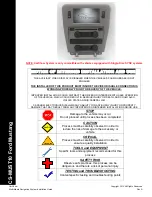
Version 3.0
1
About GPS Navigation
Operator’s Manual
About GPS Navigation
This GPS receiver is a precision navigation instrument utilizing the
latest technology available today to provide optimum performance
from the GPS satellite and Beacon land signals received. As with all
other forms of radio signals, the ultimate navigation result is depen-
dent upon the quality of these signals. Radio signals may, on occa-
sion, be distorted, jammed, or otherwise incorrect. As a result, your
position accuracy may occasionally be less than that which can nor-
mally be expected.
The Navstar Global Positioning System, commonly referred to as
GPS, is a satellite navigation system developed by the U.S. Depart-
ment of Defense to provide both military and civilian users with highly
accurate, worldwide, three dimensional navigation and time. By re-
ceiving signals from orbiting GPS satellites, authorized users are able
to continuously navigate with an accuracy on the order of 5 meters
2D RMS or better
A technique referred to as Differential GPS (DGPS), allows users to
obtain maximum accuracy from the GPS system. DGPS requires the
use of two GPS receivers. One receiver, known as the
Reference Sta-
tion
, is placed at a surveyed location, the coordinates of which are
precisely known. The purpose of the differential GPS system is to use
the reference station to measure the errors in the GPS signals and to
compute corrections to remove the errors. The corrections are then
communicated in real-time to the navigators, where they are com-
bined with the satellite signals received by the navigators, thereby
improving their navigation or positioning. The geographic validity
of these corrections decreases with distance from the reference sta-
tion, but the corrections are valid for navigators hundreds of kilome-
ters from the reference station.
Marine radio beacons operating in the 283.5 to 325.0 KHz frequency
range are in widespread use for direction finding in coastal naviga-
tion. Because the beacon system has been in place and widely used
for many years, it provides an effective means for the transmission of
DGPS signals. Depending on their local environment and power out-
put, their signals may be usable to several hundred miles. Marine
beacons provide an economical means of obtaining DGPS accuracy
for coastal navigators. GPS receivers with built-in beacon receivers
are designed to provide low cost reception of DGPS corrections broad-
cast (normally free of charge) by coastal authorities.
!
Summary of Contents for MX500
Page 1: ...oOperator s Installation Manual MX500 Navigation System ...
Page 14: ...Version 3 0 ix Table of Contents Operator s Manual ...
Page 165: ...Version 3 0 151 Configuration Operator s Manual ...
Page 167: ...Version 3 0 153 Datum List Operator s Manual ...
Page 195: ...List of Components Installation Manual Version 3 0 181 APPENDIX F INSTALLATION SECTION ...
Page 196: ...Installation Manual List of Components 182 Version 3 0 SECTION 1 LIST OF COMPONENTS ...
Page 219: ...Installation Notes Version 3 0 205 Installation Manual SECTION 5 INSTALLATION NOTES ...
Page 282: ......
Page 283: ......
















































